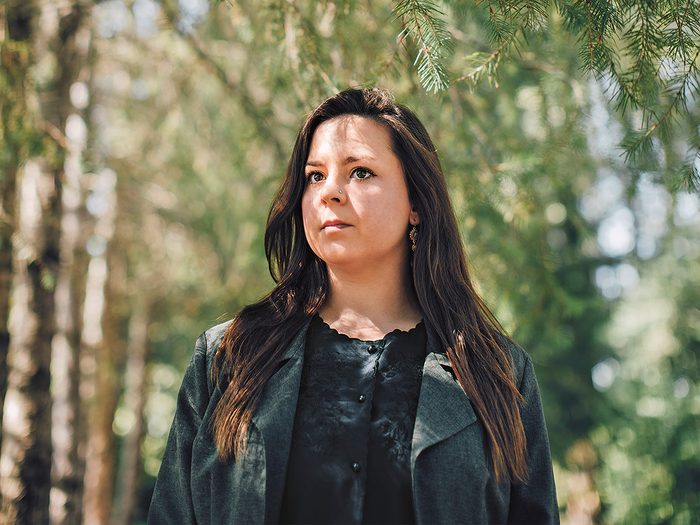I Was Diagnosed with ADHD as an Adult—My Difficult Life Finally Made Sense

For 30 years, Tracey Mellis struggled with a miserable, messy life. Then she found out why.
My mother says I babbled non-stop almost from day one, to the point where they almost named me Brook. Even though I was a tiny child—I’m still under one-and-a-half metres at age 31—I was always the loudest person in the room.
We lived in Langley, B.C. At school, I was a disruptive class clown and a constant daydreamer. It was obvious to my teachers that I wasn’t listening, and they called me on it. In Grade 5, one of them finally raised the issue with my parents. “This girl has to get it together,” he told them. I was a poor reader and writer, lagging behind the class—but mostly it was my absent-mindedness that was worrying him. “She’s so easily distracted; she needs discipline.”
The meeting put the fear into my parents, who gave me extra homework every night and sent me to a tutor in the summer. Those things helped because it wasn’t that I couldn’t learn, I just needed someone to sit with me and make me do it.
Along the way, a few teachers made it clear that they knew I was more than capable, since I aced the occasional assignment when I was actually interested. “You have so much potential. Why are you wasting it?” was a common refrain. Hearing that over and over was painful. I began asking myself the same question.
By the time I was 14, I was punching fist-sized holes in my bedroom wall in reaction to perceived slights. My emotions were in overdrive, and even small setbacks made me feel like my world was crashing down. It filled me with so much despair that I sometimes convinced myself I wanted to die. My parents finally sent me to a therapist, but the only thing I remember from those sessions is her telling me I was heading for juvenile delinquency.
I recognized that the anguish I felt couldn’t be normal, and so at age 16 I begged to be sent to a psychiatrist. He started me on antidepressants and mood stabilizers. Within weeks, I began having intense nightmares—like nothing I’d ever experienced—and my depression actually worsened as I became more agitated.
In Grade 11, I began dating a fellow rebel at our very religious school. Lasting a year and a half, the relationship ended up being one of my longest. I was generally boy crazy, falling in love frequently and indiscriminately. The infatuations were a diversion from my own feelings of inadequacy—and I craved the dopamine rush they provided. Usually, though, I’d lose interest quickly and then want nothing to do with them. Guys would also find my intensity overwhelming.
One day, a friend of mine told me she’d spotted my rebel boyfriend with another girl at a hockey game, and that night I swallowed an entire bottle of Ativan. My mom came home from work and found me stumbling around. She rushed me to the hospital, where I was put on IV fluids, monitored for 24 hours and referred to a child psychiatrist.
For the next couple of years, my parents and doctors closely watched me. Meanwhile, I was just so tired of being told by the adults in my life to simply “snap out of it” and get back on track. While my peers geared up for big and bright futures, I could only see mine disappearing.
At 18, I was on so many medications that, one afternoon while I was doing some filing for my dad at his work, I fell asleep under the desk. He called the psychiatrist and said, “What did you give my kid? She’s totally out of it!”
I temporarily stopped taking all the meds after that—long enough to pick up a little clarity and energy, and pass high school. My view of myself swung between two poles: I was either a genius prodigy or a total failure, bedridden with anxiety and unable to get to class.
After a year at community college to bump up my GPA, I was able to transfer to Simon Fraser University, where I hoped to discover a career I could stick with and find meaningful. I’d be extremely productive for a semester or two but then completely lose interest and push pause on my studies to instead work full-time as a veterinary assistant in my hometown. At the animal hospital, I felt oddly at peace among the chaos of emergencies and big emotions. It kept me distracted from my own problems, at least while I was on shift.
By age 25, I was overwhelmed by a gnawing depression. I began drinking to numb the pain—eventually to the point where I was virtually never sober outside of work. My parents were worried I was going to drink myself to death. So was I. They helped set me up in an intensive rehab and recovery facility, where I spent half a year. I got clean there but experienced a few relapses in the time that followed.
Over the next five years, as I bounced between stability and depressive episodes, I sought answers from medical and mental-health professionals. None of them agreed on what was wrong with me. More than one psychologist told me that I was just a lost young adult struggling to find myself. Doctors told me I had bipolar disorder, borderline personality disorder, premenstrual dysphoric disorder (a more severe form of PMS), anxiety and depression. I had tried treatment for all of those conditions, but nothing had helped.
Then, some hope. Two years ago, a friend referred me to a registered clinical counsellor, Jim Smith, who helped start Langley Youth and Family Services, which specializes in early intervention and preventative counselling. For decades, he had helped patients with suicidal ideation and has a special interest in attention deficit hyperactivity disorder (ADHD).
Initially, Jim guided me to trace back what thoughts provoked a particular emotion, figuring out how to express it in a more controlled way. (The simple idea that your thoughts create your emotions was a revelation to me.) But during our third session, Jim suggested that I might be suffering from ADHD.

The Diagnosis
At first I was confused. I associated ADHD with hyperactive kids and childhood learning disability, but Jim explained that it’s actually a lifelong condition. If you have ADHD as an adult, you had it as a kid—but the vast majority of adults who have it don’t know they do, because they were never diagnosed. My habit of jumping from tangent to tangent when I spoke was typical of people with ADHD, Jim said. He reassured me that the disorder can be successfully managed through counselling, medication and lifestyle changes and suggested I see a doctor who could provide a proper diagnosis and prescribe me something that could help.
I stumbled out of Jim’s office feeling a mix of emotions: shock, but also cautious optimism and relief. The diagnosis made sense, and if he was right, it would explain the driving force behind all of my struggles—the mental anguish, chronic underachievement and the need to self-medicate with alcohol and guys.
Back home, I phoned my mom and told her what Jim had said. At first, she didn’t buy it. She’s heard too many diagnoses before this one and, like me and lots of other people, she associated ADHD with hyperactive boys. As I soon learned, though, girls are significantly underdiagnosed, not just by family members and themselves but by medical professionals, too. Partly, this is because we’re blinded by gender bias. Those mood swings are just girls being girls, or later chalked up to PMS. And due to a combination of how girls’ brains work and that we’re conditioned to internalize hyperactivity and frustration, our ADHD manifests more commonly as getting lost in distractions and daydreams—and is therefore less noticeable.
That night I opened a copy of the DSM-5—the bible of psychiatric disorders—and read the symptoms of ADHD. Impulsiveness, hot temper, mood swings, poor planning, trouble focusing—I ticked every box.
Through counselling with Jim and another registered clinical counsellor named Ted Leavitt, who specializes in ADHD, I learned how cognitive therapy and learning emotional awareness can be complemented by a healthy diet, regular workouts and creative expression to help control symptoms.
But ultimately, these strategies could only take me so far, because ADHD is a neurodevelopmental disorder. Scientists believe it’s caused by a lack of communication between neurons in the brain, especially in the frontal lobes responsible for planning and mood management. And so people with ADHD need medication to keep intense emotions and scattered thoughts in check. Since psychologists can’t prescribe medication, I’d need to find a physician who was experienced with ADHD and willing to prescribe medication to an adult woman with a history of psychiatric ailment and substance use. This was no small task.
The first four doctors I saw refused. They either assumed I was an addict looking for a fix or once again suggested my issues were due to female hormones. My ADHD had slipped through the cracks throughout my whole childhood, and now it was happening again.
The Prescription
But finally, in December 2019, one of my psychologists referred me to Dr. Gurdeep Parhar, who runs one of the very few Canadian ADHD clinics specifically for adults. His office was located less than an hour’s drive away, in Burnaby, B.C.
The first thing I noticed about Dr. Parhar was his shoes: a crocodile pattern in royal-blue velvet. “I’ve got a couple of teenage boys at home and we’re competing for top fashionista around the house,” he joked.
Right away, I knew I’d like him. He and his partner, Anita, run the clinic together—her doctorate is in education, and through initial interviews, she helps piece together a client’s childhood and education history.
Dr. Parhar explained to me that the prescription-drug treatment for ADHD is long-acting psychostimulants that also have mood-stabilizing properties. Giving me a stimulant might sound like pouring gasoline on a fire, but it makes sense when you remember that there’s too little chatter going on between the neurons in an ADHD brain, not too much—a lack that leads, in turn, to dysregulated thoughts and emotions.
After my assessment at the ADHD clinic, I picked up my prescription. You know how people describe what it was like when they tried on glasses for the first time? It’s a shock because they hadn’t realized what they weren’t seeing before. My new medication was like that—like putting on glasses, but for my brain. Within a half-hour of taking that first capsule, my mind was quiet. I’d never had that feeling before. That night, I slept like a baby, and over the next few days I read a book cover to cover for the first time in my life. At the end of a week, I realized I’d gone that entire time without craving a drink.
In six months, I was off the antidepressants I’d been taking more or less continually since I was 16.
Living With Adult ADHD
In the time since my diagnosis, it’s mostly been good. I can concentrate a lot better, and my hyperactivity is reduced. There are, however, some side effects. I get occasional headaches, dry mouth and a diminished sense of creativity.
Like a lot of people with ADHD, creative projects have often been an outlet for me. Sometimes when I’m meditating, I’ll see wild colour patterns in my mind, and I often have to interrupt what I’m doing to get them down on paper. It’s a drag to lose this inspiration, which had become such a big part of my identity, so I’ll occasionally stop taking the pills for a week or so.
Although Dr. Parhar doesn’t recommend taking breaks for everybody, as that can disrupt daily functioning, a short hiatus is safe for those who can manage it. Now that I’ve experienced what a “normal” emotional response is like, I find it easier to remember during those breaks that the mood swings are temporary and that I am not my feelings.
Along with Dr. Parhar, I still see Jim regularly, and Ted has been helping me with organizational skills and career planning. I’m grateful for all the support, and I’m going to need it—because with a renewed optimism about my future, I’m back to taking on life goals. I’m at university to finish my bachelor of science degree, which has been eight years in the making. I’m just six credits short, and I can see the door open at the end of it. My plan is to apply to vet-medicine programs to pursue that vocation as a career.
Of course, at the same time, I’m hedging my bets and indulging other interests. I’m getting my international gemology certification, teaching myself metalsmithing and electroplating in order to create jewellery with gemstones I buy at auctions.
Now that I’m diagnosed and managing my ADHD, artistic pursuits that began as coping mechanisms have morphed into passions. I finally see that my emotions aren’t a flaw, but a strength.
Could You Be Suffering From Adult ADHD?
Around a million Canadians are affected by attention deficit hyperactivity disorder (ADHD), a neurological condition that shows itself in childhood, by the age of 12, with behaviours that include physical hyperactivity, inability to follow instructions and disorganization.
Over the past couple decades, the rates of ADHD diagnoses have been increasing, but this is likely not due to an actual uptick in the condition. According to Dr. Gurdeep Parhar, who co-runs the Adult ADHD clinic at Pacific Coast Recovery Care in Burnaby, B.C., a growing awareness of ADHD among physicians and in the general population has led to fewer missed diagnoses. Among those overlooked, girls and women are vastly overrepresented. Children diagnosed with ADHD are 2.5 to 1 in favour of boys, but by the time they’re adults, the diagnoses are evenly split between genders.
If ADHD isn’t identified in a child, it can be difficult to recognize in adulthood. While children display the telltale behaviours, adults with ADHD develop strategies—using apps to keep themselves organized or working long hours to get things done—and consequently can go undetected. Even before they’re aware they have ADHD, adult sufferers may find their way to meditation and breathing exercises in order to cope with outsized feelings. Eventually, however, these strategies can fail, and untreated ADHD can lead to devastating outcomes, including work problems, relationship breakdowns, traffic accidents, poor credit scores and substance abuse.
If you suspect you might be suffering from ADHD, talk to your physician or see a psychiatrist specializing in the condition. – Bruce Grierson
Next, read the true story of one woman’s mid-life autism diagnosis.






